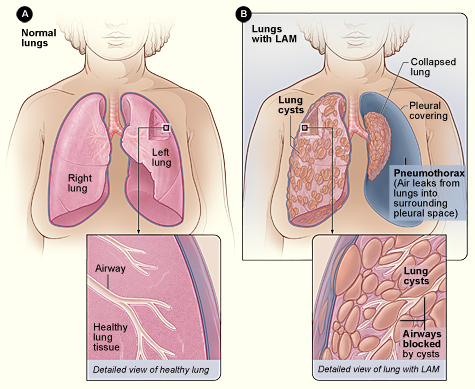Lymphangioleiomyomatosis

Lymphangioleiomyomatosis (lim-FAN-je-o-LI-o-MI-o-ma-TO-sis), or LAM, is a rare cystic lung disease that mostly affects women in their mid-forties. In LAM, an unusual type of cell begins to grow out of control throughout the body, including in the lungs, lymph nodes and vessels, and kidneys. Over time, these LAM cells form cysts and clusters of cells, which grow throughout the lungs and slowly block the airways. They also destroy the normal lung tissue and replace it with cysts. As a result, air cannot move freely in and out of the lungs, and the lungs cannot supply enough oxygen to the body’s other organs. Some people also develop growths called angiomyolipomas (AMLs) in the kidneys. There are two forms of LAM - a sporadic form, which occurs for unknown reasons, and a form that occurs in people with a rare, inherited disease called tuberous sclerosis complex.
LAM may be difficult to diagnosis in the early stages because symptoms may be similar to other lung diseases. A high resolution CT scan is the most accurate imaging test for diagnosing LAM. Additional testing may include an abdominal CT scan or ultrasound, a VEGF-D blood test (measuring the VEGF-D hormone, which would typically be high), and a lung biopsy. There are several management options for LAM, but the best course of treatment may vary from person to person. Treatment options may include therapy with an mTOR inhibitor (such as sirolimus), and supportive measures such as oxygen therapy or the use of bronchodilators. Some people may need a lung transplant when lung function is considerably impaired.
LAM may be difficult to diagnosis in the early stages because symptoms may be similar to other lung diseases. A high resolution CT scan is the most accurate imaging test for diagnosing LAM. Additional testing may include an abdominal CT scan or ultrasound, a VEGF-D blood test (measuring the VEGF-D hormone, which would typically be high), and a lung biopsy. There are several management options for LAM, but the best course of treatment may vary from person to person. Treatment options may include therapy with an mTOR inhibitor (such as sirolimus), and supportive measures such as oxygen therapy or the use of bronchodilators. Some people may need a lung transplant when lung function is considerably impaired.